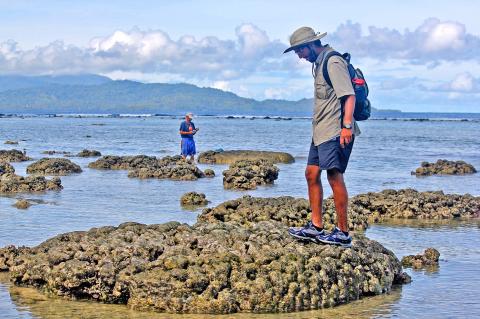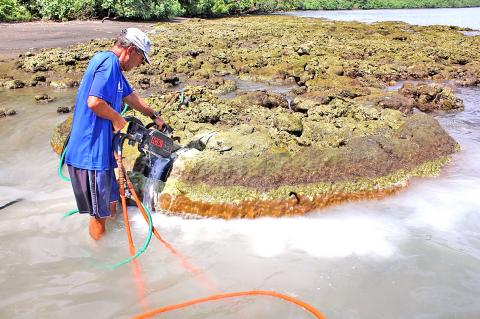Working with researchers from the University of Texas at Austin, Taiwanese geology professor Shen Chuan-chou (沈川洲) was part of a team that uncovered a history spanning millennia of seismic activity around the Solomon Islands in the South Pacific.
Until a devastating earthquake in 2007 proved otherwise, close to a century’s worth of seismic monitoring data going back to the British colonization of the area in the early 1900s had led to the belief that the region was free of large earthquakes.
The magnitude 8.1 quake in 2007 caused a subsequent tsunami that killed 52 people.

Photo courtesy of National Taiwan University associate professor Shen Chuan-chou
Coral reefs near beaches are “natural seismic activity recorders,” as they provide evidence of earthquakes, Shen said.
Through a chemical analysis similar to carbon dating, the team was able to deduce when earthquakes occurred, he said
As seismic activity usually causes land near the epicenter of an earthquake to rise, the tips of coral reefs exposed to air would be unable to continue upward growth, instead growing sideways and forming disc-shaped reefs, Shen said.

Photo courtesy of National Taiwan University associate professor Shen Chuan-chou
The coral’s elevation and time of death rendered clues about the strength of earthquakes, he said.
The Texas team, which worked around Ranongga Island in the Solomon’s Western Province, found that massive earthquakes had occurred in the region every 500 to 1,000 years over the past 4,000 years.
Lead researcher and University of Texas Institute for Geophysics doctoral student Kaustubh Thirumalai said that “this … shows the importance of paleoseismology and paleogeodesy.”
“If we have 100 years of instrumental data saying there’s no big earthquakes here, but we have paleo-records that say … five giant ones in the last few thousand years, that gives you a different perspective on hazards and risk assessment,” Thirumalai said in a recent University of Texas publication.
There is sufficient evidence showing that if the interaction model between tectonic plates does not change, the chances of large earthquakes that would threaten local populations are low, Shen said.
However, due to the frequency of tectonic activity near Taiwan and the plethora of coral reefs surrounding the nation, establishing an archive of the earthquakes that have occurred in the region would be a great benefit, Shen said.
Shen said that he has located a spot off the coast of Kenting Township (墾丁) in Pingtung County, near the Ma-anshan Nuclear Power Plant, that would be suitable for a survey and plans to conduct research on the frequency of strong earthquakes near Taiwan.
The Texas team’s findings were published in the latest edition of Nature Communications magazine, which came out on Wednesday last week, as well as in a paper published by the university.
Additional reporting by Tsai Ying

An essay competition jointly organized by a local writing society and a publisher affiliated with the Chinese Communist Party (CCP) might have contravened the Act Governing Relations Between the People of the Taiwan Area and the Mainland Area (臺灣地區與大陸地區人民關係條例), the Mainland Affairs Council (MAC) said on Thursday. “In this case, the partner organization is clearly an agency under the CCP’s Fujian Provincial Committee,” MAC Deputy Minister and spokesperson Liang Wen-chieh (梁文傑) said at a news briefing in Taipei. “It also involves bringing Taiwanese students to China with all-expenses-paid arrangements to attend award ceremonies and camps,” Liang said. Those two “characteristics” are typically sufficient

A magnitude 5.9 earthquake that struck about 33km off the coast of Hualien City was the "main shock" in a series of quakes in the area, with aftershocks expected over the next three days, the Central Weather Administration (CWA) said yesterday. Prior to the magnitude 5.9 quake shaking most of Taiwan at 6:53pm yesterday, six other earthquakes stronger than a magnitude of 4, starting with a magnitude 5.5 quake at 6:09pm, occurred in the area. CWA Seismological Center Director Wu Chien-fu (吳健富) confirmed that the quakes were all part of the same series and that the magnitude 5.5 temblor was

The brilliant blue waters, thick foliage and bucolic atmosphere on this seemingly idyllic archipelago deep in the Pacific Ocean belie the key role it now plays in a titanic geopolitical struggle. Palau is again on the front line as China, and the US and its allies prepare their forces in an intensifying contest for control over the Asia-Pacific region. The democratic nation of just 17,000 people hosts US-controlled airstrips and soon-to-be-completed radar installations that the US military describes as “critical” to monitoring vast swathes of water and airspace. It is also a key piece of the second island chain, a string of

The Central Weather Administration has issued a heat alert for southeastern Taiwan, warning of temperatures as high as 36°C today, while alerting some coastal areas of strong winds later in the day. Kaohsiung’s Neimen District (內門) and Pingtung County’s Neipu Township (內埔) are under an orange heat alert, which warns of temperatures as high as 36°C for three consecutive days, the CWA said, citing southwest winds. The heat would also extend to Tainan’s Nansi (楠西) and Yujing (玉井) districts, as well as Pingtung’s Gaoshu (高樹), Yanpu (鹽埔) and Majia (瑪家) townships, it said, forecasting highs of up to 36°C in those areas